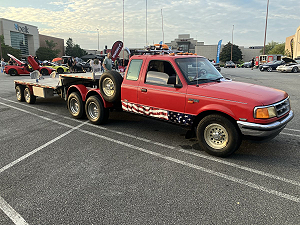- Joined
- Aug 7, 2007
- Messages
- 2,604
- Reaction score
- 18
- Location
- Opelousas La.
- Vehicle Year
- 1989
- Make / Model
- Ranger
- Transmission
- Manual
I've got two comments in reading all this: One is Derek's initial post. It would be more believable if he hadn't stated that in one molecule of water there's one molecule of hydrogen and 1/2 a molecule of qxygen. (I'm not a chemical major, but even I know that one molecule of water contains two atoms of hydrogen and one atom of oxygen)
(I'm not a chemical major, but even I know that one molecule of water contains two atoms of hydrogen and one atom of oxygen) And as for all those PhD engineers Cummins has on the payrole: I've driven trucks (18 wheelers) with their latest creations powering them and if that's the best they can do, Cummins sure as hell isn't getting what they paid for. Their 500 hp truck engine performs about as well as their old big cam 855 300 hp motors did 25 years ago. The latest craze in these hydrogen generators shouldn't be looked at as y'all are. These are better compared to storage batteries. In any electrical energy generation, there's always excess power being generated, but unless you use this power, it's lost to the grid. Use that excess power to break down water to it's components and you've found a way to capture the wasted current generated by reintroducing it into the engine. It's kinda like the way hybrid cars work. To see this happen on a bigger scale, if you ever visit the Chattanooga area, just to the west along the Tennessee river there is a facility there that takes the excess power from the grid(during low demand) pumps water up to a storage reservoir, then when there's peak demand on the grid, the water is released back thru the generators and converted back into electricity. There's another facility like it in Colorado in the upper Arkansas river valley.
And as for all those PhD engineers Cummins has on the payrole: I've driven trucks (18 wheelers) with their latest creations powering them and if that's the best they can do, Cummins sure as hell isn't getting what they paid for. Their 500 hp truck engine performs about as well as their old big cam 855 300 hp motors did 25 years ago. The latest craze in these hydrogen generators shouldn't be looked at as y'all are. These are better compared to storage batteries. In any electrical energy generation, there's always excess power being generated, but unless you use this power, it's lost to the grid. Use that excess power to break down water to it's components and you've found a way to capture the wasted current generated by reintroducing it into the engine. It's kinda like the way hybrid cars work. To see this happen on a bigger scale, if you ever visit the Chattanooga area, just to the west along the Tennessee river there is a facility there that takes the excess power from the grid(during low demand) pumps water up to a storage reservoir, then when there's peak demand on the grid, the water is released back thru the generators and converted back into electricity. There's another facility like it in Colorado in the upper Arkansas river valley.
 And as for all those PhD engineers Cummins has on the payrole: I've driven trucks (18 wheelers) with their latest creations powering them and if that's the best they can do, Cummins sure as hell isn't getting what they paid for. Their 500 hp truck engine performs about as well as their old big cam 855 300 hp motors did 25 years ago. The latest craze in these hydrogen generators shouldn't be looked at as y'all are. These are better compared to storage batteries. In any electrical energy generation, there's always excess power being generated, but unless you use this power, it's lost to the grid. Use that excess power to break down water to it's components and you've found a way to capture the wasted current generated by reintroducing it into the engine. It's kinda like the way hybrid cars work. To see this happen on a bigger scale, if you ever visit the Chattanooga area, just to the west along the Tennessee river there is a facility there that takes the excess power from the grid(during low demand) pumps water up to a storage reservoir, then when there's peak demand on the grid, the water is released back thru the generators and converted back into electricity. There's another facility like it in Colorado in the upper Arkansas river valley.
And as for all those PhD engineers Cummins has on the payrole: I've driven trucks (18 wheelers) with their latest creations powering them and if that's the best they can do, Cummins sure as hell isn't getting what they paid for. Their 500 hp truck engine performs about as well as their old big cam 855 300 hp motors did 25 years ago. The latest craze in these hydrogen generators shouldn't be looked at as y'all are. These are better compared to storage batteries. In any electrical energy generation, there's always excess power being generated, but unless you use this power, it's lost to the grid. Use that excess power to break down water to it's components and you've found a way to capture the wasted current generated by reintroducing it into the engine. It's kinda like the way hybrid cars work. To see this happen on a bigger scale, if you ever visit the Chattanooga area, just to the west along the Tennessee river there is a facility there that takes the excess power from the grid(during low demand) pumps water up to a storage reservoir, then when there's peak demand on the grid, the water is released back thru the generators and converted back into electricity. There's another facility like it in Colorado in the upper Arkansas river valley.













